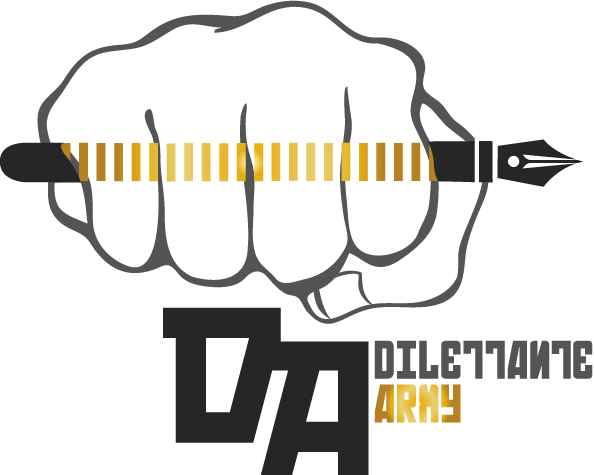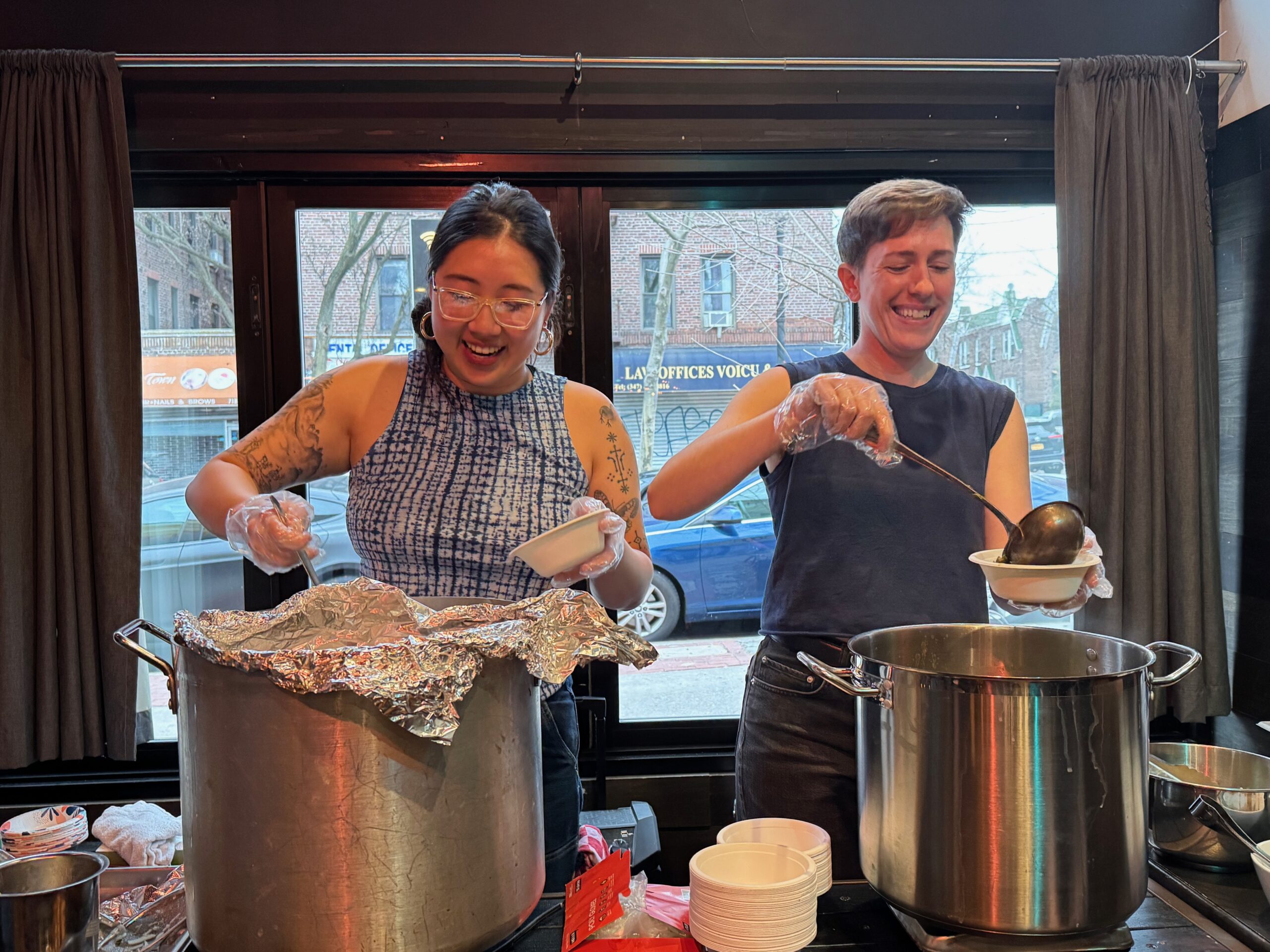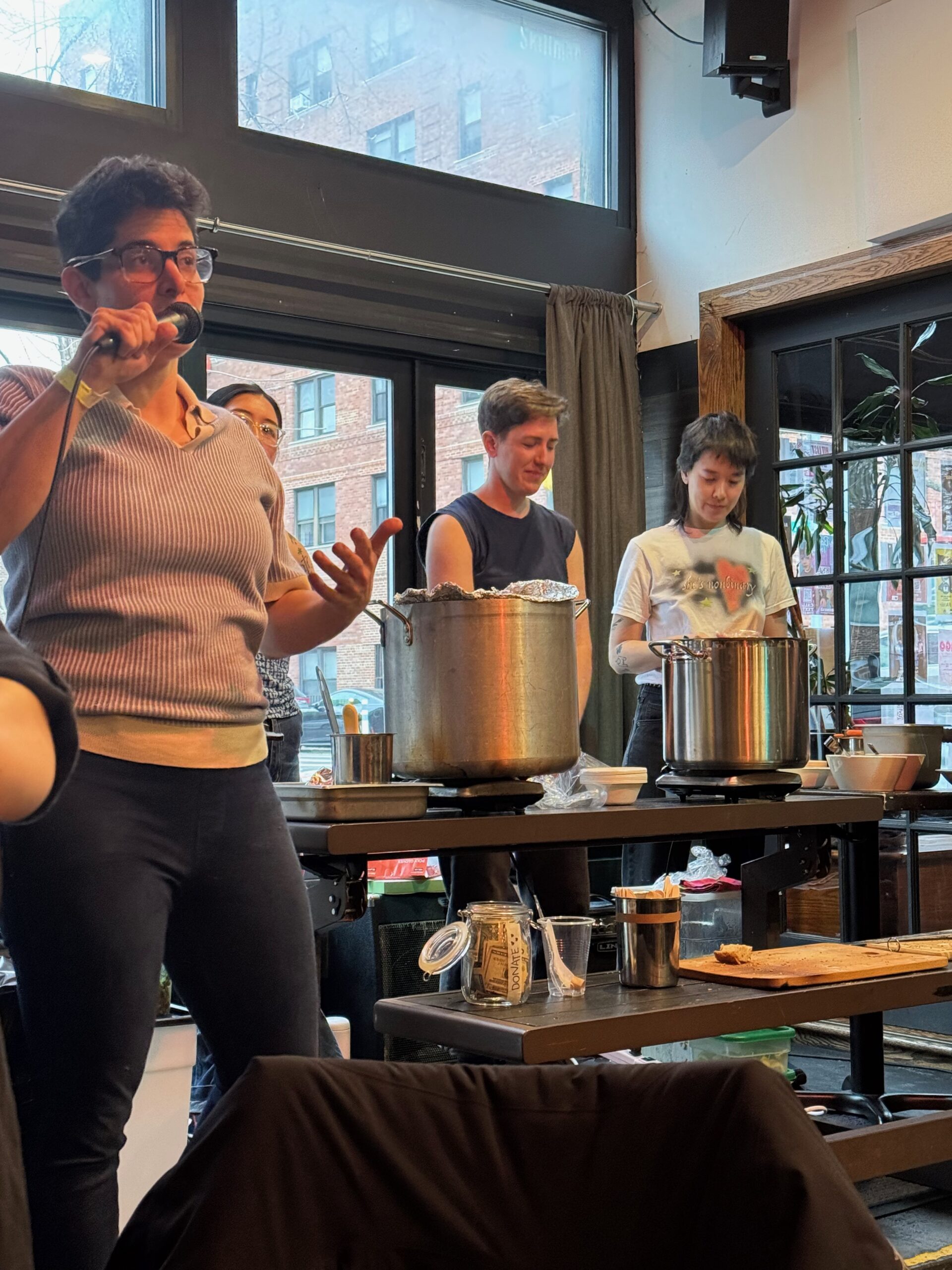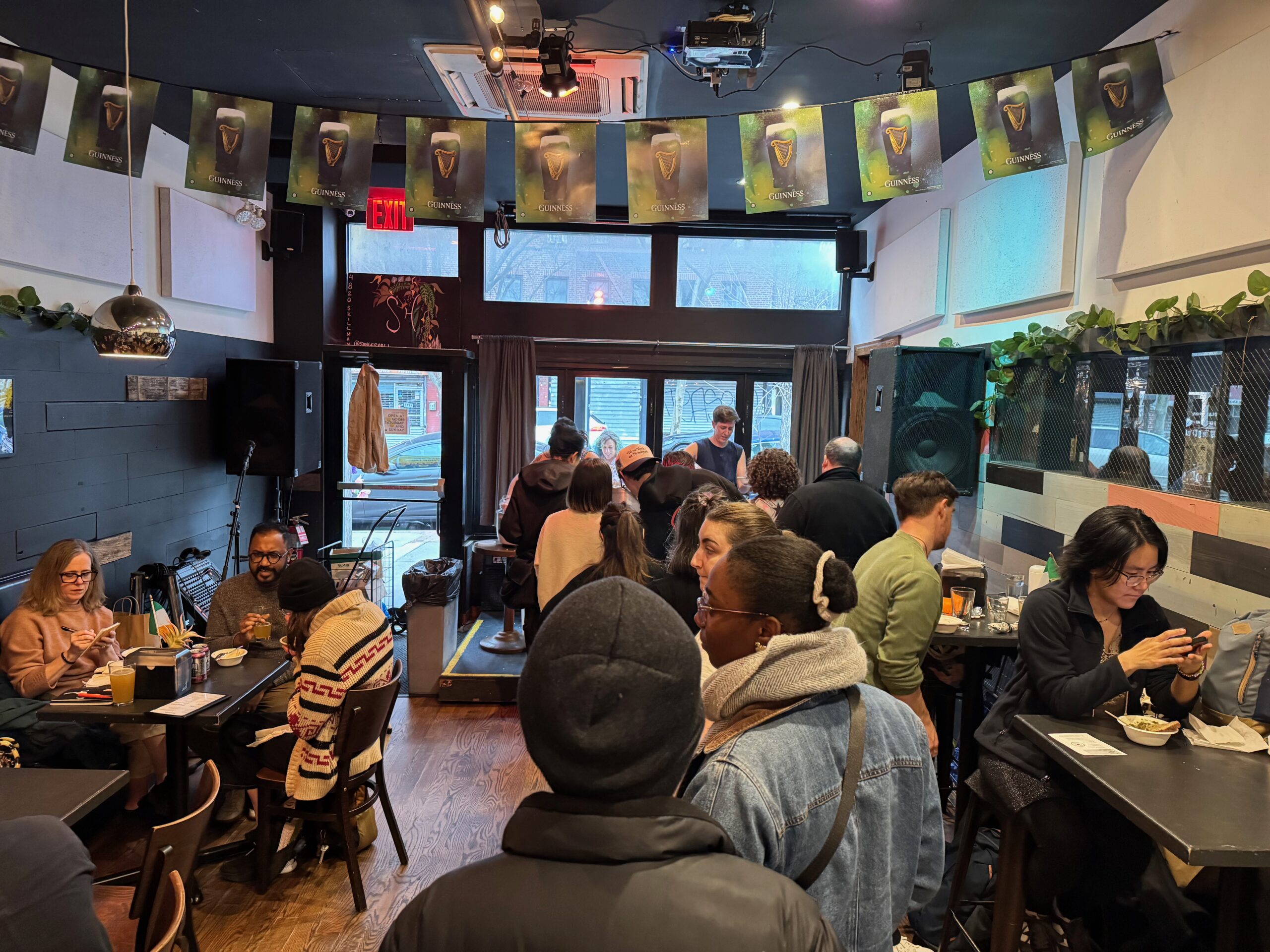Ask Me What’s Gay about Soup
The lovely young person has a tote bag slung over their shoulder. “Ask me what’s gay about soup,” it reads.
Do you tap the toter of the bag on the shoulder? Ask the question you’re asked to ask? Suggest you might go on a date? If you do, you will be told about Queer Soup Night, or QSN. Since 2017 QSN has been holding events, sprinkled across the country, at random calendrical intervals, when queer folk and their friends gather to make and eat soup together. The recipes are borrowed and shared, the ingredients are scavenged and gifted, the culinary and organizing talents shine from within. Over the course of a QSN evening, the stockpots get emptied of soup, bellies get filled, and hats are passed (or Venmo codes circulated) to raise money for local social justice organizations. Less of a soup kitchen, and more of a merry and mobile coven of spoon-wielding witches, QSN ‘s reason for being is “serving soup to those we love, raising money for those we rally with.”
From the rustic improvisations of the lesbian potluck, to the cultured but inclusive dinner party; queer meals tend to offer a larger helping of democracy than hierarchy, and they recognize that eating together is a kind of communion.[1] Queers know all too well the pain of being shunned from family dinner tables and wider communities of origin—turned away from the rituals of worship, so often food-centered, bullied in the lunchroom, stared at in the supermarket. We are experienced in making families of choice, building kinship structures that are not reliant on blood or marriage or hometown. But although we have too long and wide a history of not having a seat at the table, we have also long bested that metaphor by simply drawing up a seat—and a menu—and gathering together around a pot of our own. You are what you eat, the nineteenth-century saying goes. Queer dining modes can equally celebrate survival and memorialize loss, either way expressing a culture of community care. Sometimes, even, the meal comes to you. In the earliest days of the AIDS crisis, enflamed by the studied indifference of the nation’s president, many a grass roots meals-on-wheels care system sprouted up between the political cracks. “Moveable Feast” in Baltimore, “Manna” in Philadelphia, “Project Open Hand” in Atlanta, Chicago, and San Francisco . . . where the welfare state failed, the queer community mobilized. Now we have food organizations that care for BIPOC and trans people, “The Okra Project,” “The Black Trans Food Pantry,” “The Queer Food Foundation,” “The Iridescent Earth Collective,” “The Cuir Kitchen Brigade”—food justice collectives that emerge from and stand in solidarity with communities in need. Queers have emerged from the closet and are leading midnight raids on the kitchen.
But queer cultures and communities have centered food and food philosophies all along, haven’t they? And since good meals and queer lives are often forgotten, one of the best places to look for the traces of queer food culture is in literature. “The lamp in the spine does not light on beef and prunes,” Virginia Woolf tells us, meaning that dreary meals lead neither to art nor revolution. Contemporary queer activists know it too; that the ladle can be as powerful as the pen. At my first queer soup night in Sunnyside, Queens, I ate soups made by talented chefs who are also talented food writers. Their spine-lamps well and truly lit, their writing brings queer foodways out of the shadows; queer mycology, anti-carceral queer veganism, historic lesbian cafés, queer and trans youth in the garden, the queer-led fight to feed Ukrainian refugees, gender-affirming herbalism, and southern fried queer pride . . .
When I pushed open the door to the Sunnyside bar where I had been told Queer Soup Night was to happen, I saw two giant stockpots being heaved onto hotplates. “My trusty cauldrons,” said QSN organizer Liz Alpern, giving the pots’ broad and dented flanks a fond slap. These industrial-sized pots had been heaved around from venue to venue, serving up chef-made soups made from mindfully sourced and salvaged ingredients and brimming with amalgams of creativity and generosity. The chefs of the night, Leo Kirts and Annie Faye Cheng, are each also food writers and their soups were lyrically articulated. Cheng’s Hainanese Chicken and Coconut Soup glistened with thigh meat and was served on top of a luscious scoop of chicken fat rice. Soup number two, cooked by Kirts, was a deeply green and herbacious Ash Reshteh. This classic Persian soup came topped with noodles and fried onions and more fresh herbs. Kirts had substituted a coconut-based yogurt, laced with lemon and salt, for the traditional kashk, a fermented yogurt—a swap that made the dish vegan-friendly. “There’s a generosity to soup,” said Liz. “We use it to take care of one another. Neighbors in good health bring it to those who are sick. In most cultures, soup is a comfort food, something you remember being fed as a child.” Lesbian author Jeanette Winterson has expressed the same feeling; her Auntie Nellie fed soup to hordes of hungry neighborhood children. This common pot and big-hearted ladle taught Winterson her “first lesson in love.”[2] For Liz, soup is both an early and adult educator; “As queer adults we have to step outside the paths we were given as children. But as we get to decide how to be adults we can find our way back to soup, and get the comfort from it that we choose.”
Everyone in the bar that night was finding their way. Weaving between tables to locate the sourdough bread made and brought by Ingrid Adamson. Greeting old friends with a wave of a spoon. Making new ones over discussions of chocolate cake recipes. Two displaced Californians consoled each other about New York’s failure to grasp the true tang of a San Franciscan sourdough, then fell into silent smiles as they bit into a slice of Ingrid’s bake. Another diner, with salty tears streaking their cheeks, brought news of a broken relationship; their friend helped them off with their coat and handed them a bowl. And when the supply of bamboo spoons looked to be running low, one diner went the two blocks home and returned with his own spoon tucked into his shirt pocket. He’d grown up in Sunnyside, it turned out. Then left for a handful of years and was now returned to make this village-y neighborhood his own again. To make a life that was his, not his parents’. Eating communal soup with his own spoon.
What’s Gay about Soup
But really, what is gay about soup? If a bunch of queers are making and eating soup to raise money for queer projects, then we can certainly suppose that ispo facto, that particular soup is gay. But perhaps the connection is, shall we say, soupier than that. We have talked, since the middle of the nineteenth century, of the primeval soup from which we all crawled. Charles Darwin charmingly thought of this generative broth as a “warm little pond,” a body of water enriched with “all sorts of ammonia and phosphoric salts” that was heated up to a point where our ancestral protein materialized. Perhaps there’s something about soup’s suspensions between liquid and solid that remind us of beautiful touching and mutual upholding—how the sea meets the shore, how life emerges not from heterosex but from intermingled ingredients in constant communication. Other soup idioms remind us of struggle; we use soup to describe a disorienting fog or smog, and the phrase “in the soup” means to be in difficulty or debt, or in another old phrase, “on queer street.” That most terrible of deficits, the Irish Famine, produced the colloquialism “took the soup,” a reference to the Protestant bible societies that made food relief contingent on conversion. Because when the colonizers take first your lands, then export your crops that escaped the blight to profit from them on foreign markets, then barricade you from aid sent by sympathetic nations—they will then make you open your mouths for a spoon of their watery soup—a terrible, triumphalist parody of your communion wafer and wine. Pleasure, struggle, suspension, suffering, joy, resistance, all mixed up and democratically distributable among many . . . yes, soup is gay. From soup to nuts!
The brown bags that stood around in the bar at Sunnyside were fully on the joyful side of things, full neither of (un)charitable relief nor hypocrisy. Stamped with “M-W,” they had been brought by Aja and Melody, girlfriends and co-workers at “Monday Through Wednesday.” It is an organization that helps distribute “the best produce in NYC,” said Asia with quiet pride; providing high-end restaurants with top-quality produce from farms too small to get into farmer’s markets. It then also salvages produce that might otherwise go to waste. Melody led me through the contents of my bag, encouraging me to munch on pea shoots complete with mauve flowers, to stroke some cilantro more delicate and frondy than any I’d met before, to admire tumescent spears of sprouted broccoli and to exclaim over the knobbly knuckles of Jerusalem artichoke. Finding such joy in wayside vegetables, the most fresh and sproingy kind of flotsam and jetsam—together we were practitioners of the peculiarly queer art of salvage. Of taking that which might be considered too weird or too scrappy, and inviting people to enjoy its small overlooked glories, and go home and make something of them. Each bag was an invitation to engage skill and imagination to give this miscellany their best vegetable destiny.
Thinking about our best destinies informs QSN’s modes of fund-raising, too. QSN partners with local organizations to provide mutual aid—that form of community care that differs from non-profits or charities with top-down, air-lifted in modes of relief. Mutual aid operates from a position of solidarity, offering, as Dean Spade puts it, a kind of “radical collective care” and “transformative alternative” that mobilizes resistance and doesn’t require its beneficiaries to trade liberation for survival. The Sunnyside/Woodside Mutual Aid fund received the donations we made for our Ash Reshteh and chicken soup that night. Another spring event, run by the Philadelphia QSN chapter, benefited West Philly Bunny Hop, a five-year-old volunteer-led mutual aid fund providing “Free Food for the People . . . no questions asked!” Donations made by soup eaters at that event helped fill the Bunny Hop’s community fridges and fund weekly food deliveries to over 350 households in Philly. This soup night took place under the stars on a plot in North Philadelphia owned by the New Kensington Community Development Corporation (NKCDC). A table piled high with free take-home vegetables centered a ring of soup stations where stubby paper beakers of delicate or hearty or witty soups were dished up by their makers. “We invited the chefs to get fancy,” said Philly QSN chapter co-founder Jena Harris. Among a wide array of glorious soups, a scoop of macaroni and cheese drowned in French onion soup was offered by Cat Downs of The People’s Fridge, a one-ton, three-door florist’s fridge in West Philly that offers free homemade food and clean water on a 24-hour basis. A particularly winsome cold beet concoction topped with a crescent of blood orange and an orb of coconut cream was served up by Jamilah Abdullah, founder of Free Food for All, a Delaware mutual aid organization that provides fresh, Halal, culturally diverse meals, “promoting wellness and combating food apartheid.” We visited each station, revisiting favorites and discussing them with their chefs. Participants were invited to wear colored stickers that informed new friends how interested they were in “stirring” or “simmering” soup— an easily-read register of how open they were for dalliances. And if encounters with soup or humans became too much, a low-stim area was set up at the far end of the property, with hammocks and giant cushions, where soup-eaters could chill before diving back into the crowd for more.
Philly was feeling the first hints of spring, and organizers hoped that gathering this queerly rag-tag pack of humans to slurp soup, flirt, cocoon, and dance to a custom playlist would wave a reanimating wand over a special plot of land that has gone through more than its fair share of exploitation and abandonment. For twenty-five years this corner lot was home to a nonprofit called Greensgrow that had, against the odds, reclaimed a one-acre contaminated Superfund site by installing raised beds, greenhouses and hydroponic grow systems. The visionary who pushed open the broken gates of a former galvanized steel plant in 1997 and saw an urban farm, complete with a CSA, community workshops, and a pig called Milkshake rootling around one corner, was a lesbian chef called Mary Seton Corboy. Corboy, who would go on to win national acclaim for her greening of this neglected neighborhood, died in 2016, and once again this plot fell into neglect and slumber. Today it is a ghost of itself; its hoop houses are skeletons and its pig pen empty. But its revival is already underway. if you take a walk along its wire fenced perimeter you will also see plucky green or pink or purplish sprouts thrusting through the dirt. If you know your botanicals, as new Community Farmer Catherine Reuter does, you might recognize these sprouts as native False Indigo and baby pawpaws – the only tropical fruiting tree native to North America. Reuter is NKCD’s urban agriculture program manager, and the task ahead of her is to work a second miracle, and to do it in these newly terrible times of drilling and polluting, of blasting communities, of re-seeding urban blight and rooting out all things that nurture the queer and trans, the Black and Brown among us.
Queer Earth
But plants don’t care about regime change. Are—arguably—heedless of tyrants. Plants do their “thinking without a head,” as philosopher Michael Marder puts it. It is a powerful resurrection when a rye grass shoot pushes through neglected soil, or a horsenettle fruits with nobody having tended to it. Poppies, after all, thrive in soils disturbed by the horrors of war. Are these not small revolts? And haven’t queer folk always recognized the sensual and spiritual and political power of soil? Despite being accused by heterosexuals of being “against nature,” and despite the common-among-us notion that coming out means moving out of rural spaces, queers have often yoked themselves to earth-based movements; the land dykes of the 1960s and 70s, the neopagan Radical Faeries, the transmasc lads who reach for woodsy, “forestcore” names. Queer-made intentional gendered spaces have taken many forms—some of them exclusionary—but they share an antipathy to patriarchal systems and a desire for better relationships between themselves and the ground that nurtures them. As community spaces are shuttered, as our names and histories are erased from museums and arts programs, shall we gather in even fuller numbers in gardens and woodlands? After all, identifying as queer has always been a defiant allegiance with the discarded. When we march under the sign of queer, we take a homophobic slur and strut with it. We demonstrate that beauty and pride can bud and leaf from out of trash piles, or between paving cracks.
Queer farming movements show us how to launch lower-case, everyday revolutions. The kind that can take hold by casting seedpods to the four winds or spreading rhizomatically, underground. The kind that scholar Catriona Sandilands calls “eco-sexual resistance.” What are the small acts of resistance and persistence and infiltration that would never be noticed by politicians in ill-fitting suits taking to the skies to private jets? “Does the eagle know what’s in the pit,” mused the revolutionary poet William Blake, “Or wilt thou go ask the mole?” Illustrator as well as poet, he encircled his question with a delicate watercolor frame of a vine in leaf. In a world where questions are considered treason, and our chosen names and vocabularies are being stricken from the record, tendrils just keep tendrilling around. Growth is stealth! Plants have no respect for property lines, and don’t even need (as Greensgrow proved) ideal conditions. Mushrooms, as anthropologist Anna Tsing has taught us, can thrive in atomic (and capitalism’s) fallout. The Guerilla gardening movement grasps hold of this plant-led politics, uncoupling land from legal rights; guerilla gardeners aren’t given land, they simply take it. Or, rather—because how can land in fact be taken anywhere?—they tend it. Practices of wildcrafting, wildharvesting, or wildtending understand themselves as ways to heal our alienation from the bounty of the earth. Robin Wall Kimmerer, botanist author and enrolled member of the Citizen Potawatomi Nation, calls wildtending “The Honorable Harvest.” Honorable harvesting might not recognize land ownership, but it does, in fact, involve asking permission from authorities. Ask the person who tends the tree from which you want the peach leaves. Ask those who’ve harvested before you and know how to read the landscape. And ask the plant itself if they are willing. Listen to the answer. “Introduce yourself,” advises Kimmerer, “Never waste what you have taken. Share.”
Spoons and Pots
The daddy of all manner of wildness—of woods and winds and flowers and cries—is Walt Whitman. In Whitman’s poetry, ecology and democracy are entwined like lovers, and the body sings out whether in ecstasy, hunger, or pain. “I act as the tongue of you,” he pledges. “Tied in your mouth, in mine it begins to be loosen’d.” We are his common pot, and he is ours. In sickness and in health. In health and especially in sickness. During the United States’s Civil War, Whitman settled in D.C. to be a volunteer nurse in army hospitals. In June of 1864, surrounded by the “putrefactions” of war and war wounds, Walt wrote home to his mother. He laments that all around him boys are wasting to skeletons, even the “noblest specimen.” He shakes his handsome head, seeing too much death visiting too many young men. It has made him altogether blue, he confesses, and he is sorry his letter has turned so gloomy. But—“O, I must tell you”—he bought ten gallons of ice cream, which he took round himself to fifteen large wards, giving everyone—including those who “cannot probably live”—refreshment from relentless suffering. For many of these men, Whitman tells his mother, it was not only their last, but also their first taste of ice cream. The scene is clenching: Western country boys raised on hot dry prairies, dying in military hospital tents far from home, encountering never-before-dreamed-of sweetened milk that has been iced and churned into temporary solidity. These soldiers were fading just as surely as ice cream melts in a summer of fever and sepsis. But the kind-eyed, bearded poet sat by their cots and spoon-fed them, like they were children again. And they were, he would say, “my own children or younger brothers.”
The poet himself wrote about this to the woman who had herself breast and then spoon-fed him, the second of her nine children, and later, in her old age and ill health, he would care for her too. As he himself told us in his poetry, and as many have accepted in the century and more since he left us, we queers are all the children, the brothers, the mothers, the lovers of Whitman. He has fed us all, one way or another. Bread and roses, too; he scattered the flowers of the field—dandelion blossoms and red and white clover—on soldier’s cots, as a mnemonic of life in bloom. When he dipped his spoon into gallons of ice cream purchased with his own small income, he comforted a nation “brought to hospital in her fair youth.” He couldn’t save the patient, but he could tend to them in their worst hours, write home for them, receive their benedictions; “Many a soldier’s kiss dwells on these bearded lips.” Lips that can kiss, shape words, smile or grimace, and open enough to receive the nipple or the spoon, are surely the most tenderly capable organs. And Whitman is our most muscular and lyric voice of democracy. Our ice cream is certainly melting now. Our ice caps too. But can we take strength again—this time with soup—from his communal, comradely and loving spoon?
QSN reminds us that spoons and pots are always to hand. And that parable we all seem to have been raised on, the one about how a soup can be made from water and stone and community? If we can detach it in our minds from the numbing, crossed-legged lessons of kindergarten, maybe we can understand it as embodying a peculiarly queer ethic. “Soup is scrappy,” enthused Liz Alpern, “you can make it from things forgotten in the bottom of your fridge. Just throw anything in and make something beautiful out of it!” Then add people. Forgotten people especially. Take care of them, fold them in, make spaces for living and loving that are delightfully different from the confining spaces of the heterosexual, nuclear family. “Maybe the real question,” says Jena Harris, “is what isn’t gay about soup?”
[1] Kate Thomas, “Regarding The Lesbian Potluck,” in Food Rules & Rituals: Proceedings of the Oxford Symposium on Food and Cookery 2023, ed. Mark McWilliams (Prospect Books, 2024), 355-364.
[2] Jeanette Winterson, Why Be Happy When You Could Be Normal? (Grove Press, 2011), 109.






Dilettante Mail
Get updates from us a few times a year.